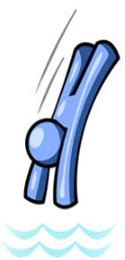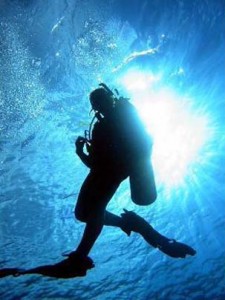
All good things come to an end, and at some point your dive will be over. Ascending at the end of a dive should be carried out with great care. This is the part of the dive where decompression sickness can develop, so your ascent must not be hurried.
When to ascend ?
Dives often end when you reach a prearranged time to surface, either to meet the boat cover or to account for changing tides. However, you may decide to ascend before this if the site proves uninteresting, or if you or your buddy are cold or tired. You may also be forced to ascend if you have only 725 psi (50 bar ) left in your tank, if you are making a decompression dive and reach the scheduled minimum volume of air in your tank, or if problems cause you to abort the dive.

Before ascent, you and your buddy should signal the “thumbs up” to each other that you are both able and ready to ascend to the surface. If possible, avoid making a “free ascent,” with no visual reference to guide you. If you can follow a reef wall or a permanent mooring line, for example, this will give you a natural sense of your ascent rate, in addition to your computer readings, and can help avoid disorientation. Sometimes, though, it is not possible to ascend up a line or along a natural feature, and it can be helpful to deploy a delayed surface marker buoy ( DSMB ) this will give you a vertical reference and also signals your position at the surface. Ideally, both members of the buddy pair should carry a DSMB. If you are diving on a wreck or a site with a guideline, aim to get back to the line for your ascent—not only will boat cover know where to pick you up at the surface, but the line will assist you in making decompression stops and, in a current, can provide something to hold on to. If you do not manage to get back to the guideline, send up a DSMB.
Making your ascent
To start your ascent, slowly breathe in or let a little air into your BC—this should cause you to rise up. Rise up next to, and ideally face-to-face with, your buddy so that you can check each other’s rate of ascent and condition. As ascent continues, carefully monitor the amount of air in your BC (and drysuit if relevant)—the air will expand as the pressure decreases during your ascent, causing your rate of ascent to increase rapidly. Keep one hand on the BC exhaust hose in order to vent air from it as you ascend. You may also need to dump air from your drysuit. You can fin to assist your ascent, especially to gain momentum to begin with, but this will not be necessary if you are correctly weighted and positively buoyant. Keep breathing normally and do not hold your breath. A conservative estimate of a safe rate
of ascent is 50 ft (15 m) per minute (or slower) up to 16 ft (5 m) in depth. At this point many divers make a 3-minute safety stop. Whether you do or not, the last 16 ft (5 m) to the surface should take another full minute. If making a decompression dive, make all your scheduled safety stops and check with your buddy as you do so.
Essential Tips
Always monitoring a dive computer. Dive computers help the diver judge ascent rate. Some devices give audible warnings if safe limits are exceeded.
Signaling to ascend. To ask your buddy if they are ready to ascend, or to signal your intent, raise your thumb (common underwater sign). Many amateur divers thinks that thumbs up means OK , in languauge of scuba diving it is simply a signal to ascend
Buddy pair ascending a guideline. A buoyed line moored to a wreck or seabed feature offers one of the safest guides for an ascent, especially in a strong current.
Following a slope. Ascending next to a natural feature, such as a reef, offers a reassuring reference point.
Making a safety stop. Divers make a precautionary safety stop at 16 ft (5 m) to allow nitrogen to exit the body’s tissues at a safe rate.
Deploying an inflatable buoy. Await recovery at the surface from your boat cover, which will have sighted the buoy at the start of your ascent. The buoy should be left in its inflated state until you have been recovered.